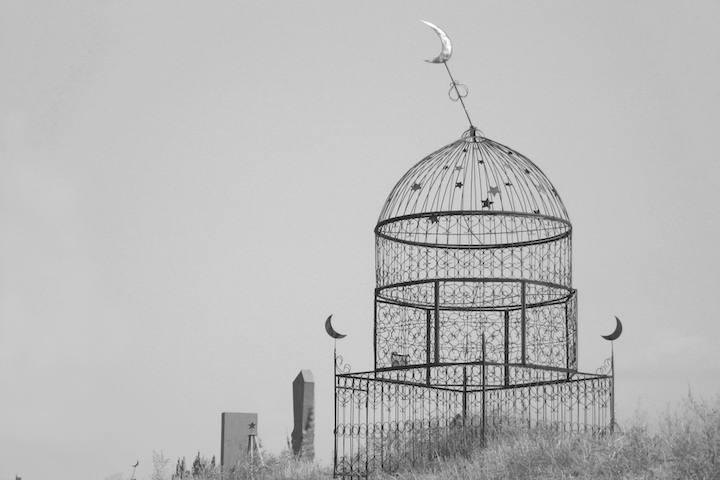Margaret Morton: Cities of the Dead

In Margaret Morton’s new book, Cities of the Dead: The Ancestral
Cemeteries of Kyrgyzstan, a mythical landscape emerges from the dust under the scrubby mountains of Central Asia’s high plateau desert.
Her photographs, rendered in a middle gray scale that enhances the sense of the aridness of the place, are devoid of people. For that reason, the structures that almost blend in with the land—minarets, yurts, and miniature taj-mahals—are impossible to measure by eye. Some are built of stone, others are skeletal forms crafted of metal rods.
Many of these uninhabited “settlements” are built in rows that stretch at great length along the undulating terrain. Ms. Morton’s visits, between 2006 and 2008, to 40 sites in this almost-impenetrable landscape, resulted in an astounding collection of images never before presented in a photobook.
The strange beauty of these cemeteries is inscrutable. She writes, “A Kyrgyz Muslim cemetery seen from a distance is astonishing. At first it seems a mirage. The ornate domes and minarets are so completely at odds with the desolate mountain landscape. The opulent structures are surprisingly smaller than they seemed from afar. Graceful crescent moons float above cupolas and peaked towers, balanced on fragile metal rods. These miniature walled cities of the dead reveal the complex nature of the Kyrgyz people’s religious and cultural identity, which combines early Shamanistic and Buddhist customs with Muslim architectural forms and Soviet influences.”
Here, Ms. Morton shares notes from her travels in Kyrgyzstan.
My first trip to Kyrgyzstan was in July 2006, with Virlana Tkacz, Manhattan theatre director of Yara Arts Group, who had invited me to photograph sites referenced in a Kyrgyz epic poem that she planned to perform at LaMaMa Experimental Theatre.
As we traveled a deserted road along the windswept south shore of Lake Issyk-kul, one of the largest mountain lakes in the world, a magnificent miniature city suddenly came into view. As we drove by, the majestic forms compressed and flattened. I was transfixed by the illusion.

I photographed cemeteries when we could stop and mapped those I saw on distant mountains. When I returned to Kyrgyzstan the following summer, Virlana introduced me to Kyrgyz scholar, Dr. Elmira Köchümkulova, Research Associate at University of Central Asia, in Bishkek, the capital city. Dr. Köchümkulova had written her doctoral dissertation at University of Washington, Seattle, WA on Kyrgyz nomadic traditions, including a chapter on the funeral rites. As an insider/native researcher she also had participated in funeral rites of family members and sung women’s ritual lamentations.
Dr. Köchümkulova traveled with me to Naryn and Osh Provinces and shared both her insights and her parents’ home in Jala-Abad Province, where we visited the remote cemeteries of her family’s tribe. Dr. Köchümkulova, who is now Coordinator, Cultural Heritage and Humanities Unit at UCA, contributed the introduction to this book.
The cemeteries of Kyrgyzstan are architecturally distinctive and culturally revealing. At various historical periods, major religions such as Buddhism, Zoroastrianism, Nestorian Christianity, Islam and Sufism all made their way to the nomadic populations living along the Silk Road. Since their adoption of Islam, a process that lasted for several centuries, the Kyrgyz incorporated many Muslim funerary traditions and burial customs, but did so without replacing their core pre-Islamic funeral customs and rites, that are still evident today.

Unlike other Muslim cultures, where religious laws forbidding high tombs and markings on graves are strictly observed, Kyrgyz traditionally mark their graves with a variety of structures to honor the deceased. The majority of Kyrgyz cemeteries present this very complex nature of the people’s religious and cultural identity and include many “un-Islamic” motifs based on pre-Islamic beliefs in animism, shamanism, and ancestor worship that combine with Islam and Sufism and, in more recent years, Russian and Soviet influences. During the seven decades of Soviet-led secularization and de-Islamization of Central Asia, most of the country’s mosques were destroyed or turned into public buildings.
The Muslim cemeteries, however, survived unscathed. The local state officials and Muslim clergy rarely interfered with people’s traditional customs, especially the life cycle ceremonies, including the funerals in rural areas. One of the more surprising juxtapositions of the spiritual and secular is a tomb on which the Muslim star and crescent is paired with the Soviet hammer and sickle.
In southern Kyrgyzstan, Dr. Köchümkulova brought my attention to a row of trees with branches bowed from the weight of overripe apricots and remarked, “Trees that bear fruit in Kyrgyz cemeteries are left untouched.” Although we rarely saw people in Kyrgyz cemeteries, horses, donkeys, and cows quietly grazed where walls had crumbled. View more images
Wednesday, November 12, Slide lecture, book signing, 7-8:30 pm Margaret Morton | Cities of the Dead: The Ancestral Cemeteries of Kyrgyzstan (University of Washington Press 2014). St. Mark’s Bookshop, new location 136 East 3rd Street, NY, NY (just west of Avenue A).

Margaret Morton has been engaged with the photographic representation of alternative built environments for more than twenty years and has published four books: Fragile Dwelling (Aperture Foundation); The Tunnel: The Underground Homeless of New York City (Yale Press and Schirmer/Mosel, Germany); Transitory Gardens, Uprooted Lives, co-authored with Diana Balmori (Yale Press); and Glass House (Penn State Press). Morton received her MFA from Yale University and is a full-time professor at The Cooper Union, School of Art, New York City.


